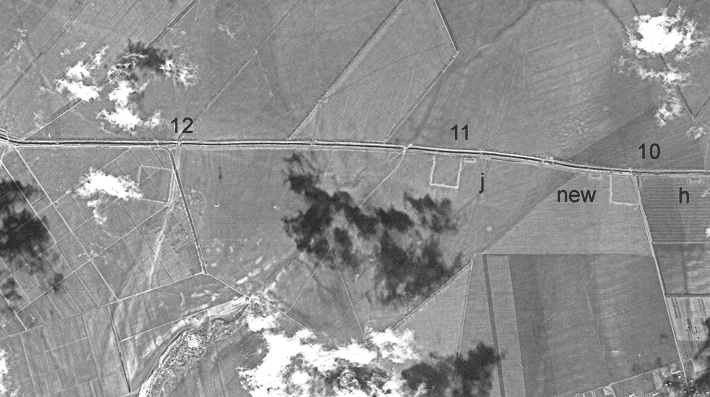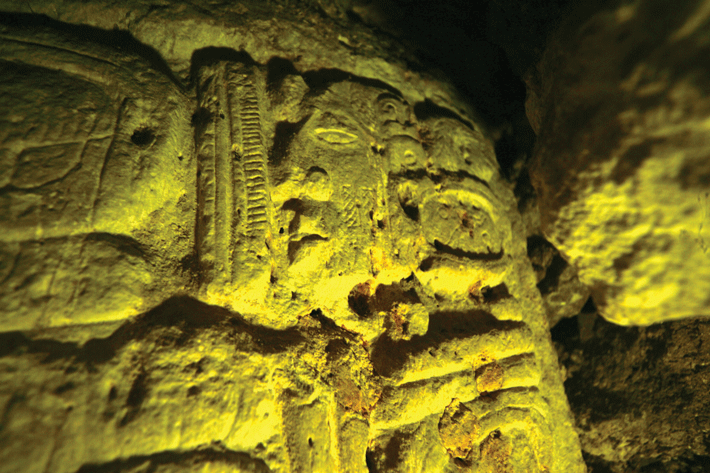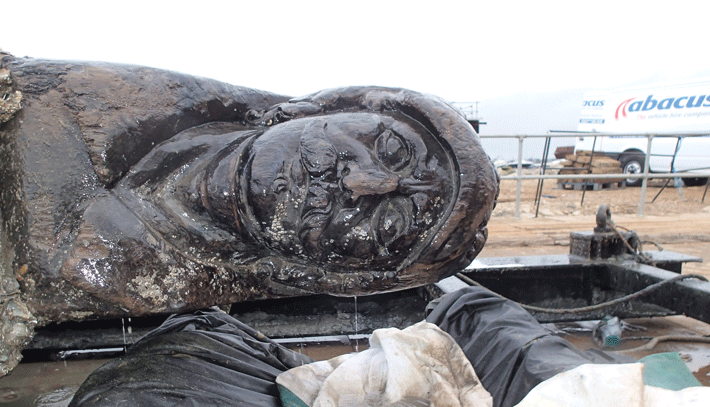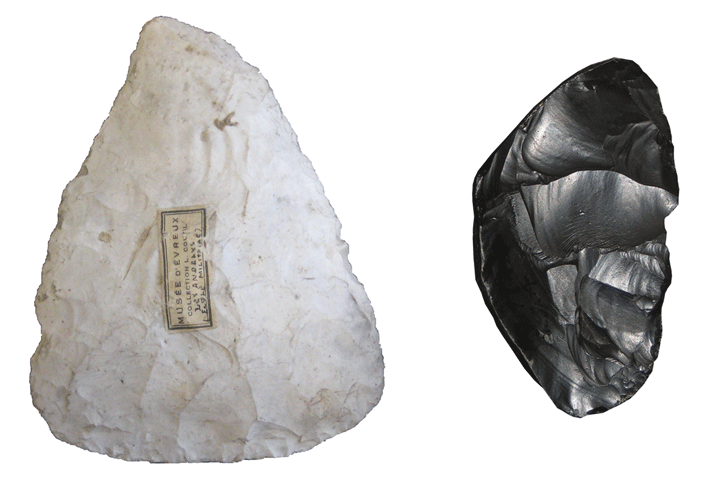From the Trenches
Spying the Past from the Sky
By NIKHIL SWAMINATHAN
Tuesday, October 15, 2013

Half the archaeological sites discovered in Britain over the last 70 years were found via aerial photography. Archaeologists continue to dig through World War II reconnaissance and recently declassified U.S. surveillance satellite photographs to uncover new ones.
William Hanson of the University of Glasgow and Ioana Oltean of the University of Exeter have brought this technique to the eastern Romanian region of Dobrogea, studying 1960s photographs of the area. They noticed three distinct, overlapping fortifications stretching over 38 miles—two of earthwork and one of stone—with more than 30 forts attached. The structure of the barriers is similar to that of Hadrian’s Wall in England. The team suggests the fortifications could date to the second century A.D., when they might have been the Roman Empire’s easternmost frontier defenses.
“This photography shows the landscape as it was before the destructive impact of later twentieth-century development,” Hanson explains, adding that such photography of the Middle East is also available. “The potential to change our understanding of the historical landscape in such areas is considerable.”
The Snake King's New Vassal
By ZACH ZORICH
Tuesday, October 15, 2013

A stela recently discovered by a team led by David Freidel of George Washington University records previously unknown events that followed a turbulent period in Maya history. In A.D. 562, Tikal, capital of a powerful Maya empire, fell to forces of the Snake Dynasty. This shift in power rippled through Mesoamerica. On the stela, found at the ancient city of Waka’, 40 miles from Tikal, glyphs record a ceremony in which a lord named Wa’oom Uch’ab Tzi’kin (He Who Stands Up the Offering of the Eagle) ascended to the throne of Waka’ as a vassal of the Snake Dynasty, probably replacing a ruler who owed his allegiance to Tikal. The monument also mentions Lady Ikoom, a Snake queen who might have been the new ruler’s mother, and it was found in front of the tomb of another powerful, later Snake queen named K’abel (“Uncovering a Maya Warrior Queen,” May/June 2013).
Dutchman Out of His Depth
By ERIC A. POWELL
Tuesday, October 15, 2013

Archaeologists excavating a seventeenth-century Dutch merchant ship off southern England have recovered a 30-foot-long oak rudder decorated with a Baroque carving of a mustachioed man. Bournemouth University’s David Parham first saw the carving while surveying the wreck. “It was a shock,” he says. “Usually in archaeology you only encounter skeletal remains of people. But this carving had to have been modeled on a real person. Here I was looking at him face to face. He struck me as looking mournful.”
Catching a Ride from Ireland
By SAMIR S. PATEL
Tuesday, October 15, 2013
 Snails aren’t known for their ability to get around. But then there’s the strange case of Ireland’s grove snails, Cepaea nemoralis, a common European land species. Geneticists from the University of Nottingham looked closely at the lineages of this species and found that the Irish variety is most closely related to the lineage found in the Pyrenees, along the French-Spanish border—and nowhere else. There are a number of other species, including the strawberry tree and the Kerry slug, with similar distribution patterns. The researchers believe that direct movement of Mesolithic people between the two sites is the simplest explanation for the unexpected biogeographic quirk. People are known to have been in Ireland around 8,000 years ago, when the snails first appeared, and grove snails are known to have been on the Mesolithic menu across the Mediterranean. The snails may have been more than hitchhikers—they may have been cargo.
Snails aren’t known for their ability to get around. But then there’s the strange case of Ireland’s grove snails, Cepaea nemoralis, a common European land species. Geneticists from the University of Nottingham looked closely at the lineages of this species and found that the Irish variety is most closely related to the lineage found in the Pyrenees, along the French-Spanish border—and nowhere else. There are a number of other species, including the strawberry tree and the Kerry slug, with similar distribution patterns. The researchers believe that direct movement of Mesolithic people between the two sites is the simplest explanation for the unexpected biogeographic quirk. People are known to have been in Ireland around 8,000 years ago, when the snails first appeared, and grove snails are known to have been on the Mesolithic menu across the Mediterranean. The snails may have been more than hitchhikers—they may have been cargo.
Neanderthal Tool Time
By ZACH ZORICH
Tuesday, October 15, 2013

Neanderthals seem to have produced a remarkably consistent set of stone tools for hundreds of thousands of years. Two new studies suggest that this presumed lack of diversity and innovation might not be the whole story.
Karen Ruebens, an archaeologist at the University of Southampton, analyzed more than 1,300 stone tools from European Neanderthal sites dated to between 115,000 and 35,000 years ago. She found that they belong to at least two distinct tool-making traditions. West of the Rhine River, Neanderthal hand axes are oval or roughly triangular, while to the east, they are rounded on one edge and flat on the other. Near the Rhine, the traditions seem to overlap, as if two cultures were sharing their techniques.
A separate study, led by Marie Soressi at Leiden University, shows that Neanderthals also may have taught our Homo sapiens ancestors a thing or two. Soressi’s analysis shows that Neanderthals were using bone tools called lissoirs to process animal hides several thousand years before the first modern humans arrived in Europe and started making the same type of tool. While it has long been thought that H. sapiens were the progenitors of the practice, Neanderthals may actually have been more creative in their tool-making than was previously thought.
Advertisement
Advertisement
IN THIS ISSUE
From the Trenches
An Imperial Underworld
Off the Grid
Splendid Surprise
Neanderthal Tool Time
Dutchman Out of His Depth
Catching a Ride from Ireland
The Snake King's New Vassal
Spying the Past from the Sky
Byzantine Riches
The Neolithic Palate
Secrets of Life in the Soil
Who Was First to the Faroes?
Drones Enter the Archaeologist's Toolkit
Advertisement

Recent Issues
-
 May/June 2024
May/June 2024
-
 March/April 2024
March/April 2024
-
 January/February 2024
January/February 2024
-
 November/December 2023
November/December 2023
-
 September/October 2023
September/October 2023
-
 July/August 2023
July/August 2023
-
 May/June 2023
May/June 2023
-
 March/April 2023
March/April 2023
-
 January/February 2023
January/February 2023
-
 November/December 2022
November/December 2022
-
 September/October 2022
September/October 2022
-
 July/August 2022
July/August 2022
-
 May/June 2022
May/June 2022
-
 March/April 2022
March/April 2022
-
 January/February 2022
January/February 2022
-
 November/December 2021
November/December 2021
-
 September/October 2021
September/October 2021
-
 July/August 2021
July/August 2021
-
 May/June 2021
May/June 2021
-
 March/April 2021
March/April 2021
-
 January/February 2021
January/February 2021
-
 November/December 2020
November/December 2020
-
 September/October 2020
September/October 2020
-
 July/August 2020
July/August 2020
-
 May/June 2020
May/June 2020
-
 March/April 2020
March/April 2020
-
 January/February 2020
January/February 2020
-
 November/December 2019
November/December 2019
-
 September/October 2019
September/October 2019
-
 July/August 2019
July/August 2019
-
 May/June 2019
May/June 2019
-
 March/April 2019
March/April 2019
-
 January/February 2019
January/February 2019
-
 November/December 2018
November/December 2018
-
 September/October 2018
September/October 2018
-
 July/August 2018
July/August 2018
-
 May/June 2018
May/June 2018
-
 March/April 2018
March/April 2018
-
 January/February 2018
January/February 2018
-
 November/December 2017
November/December 2017
-
 September/October 2017
September/October 2017
-
 July/August 2017
July/August 2017
-
 May/June 2017
May/June 2017
-
 March/April 2017
March/April 2017
-
 January/February 2017
January/February 2017
-
 November/December 2016
November/December 2016
-
 September/October 2016
September/October 2016
-
 July/August 2016
July/August 2016
-
 May/June 2016
May/June 2016
-
 March/April 2016
March/April 2016
-
 January/February 2016
January/February 2016
-
 November/December 2015
November/December 2015
-
 September/October 2015
September/October 2015
-
 July/August 2015
July/August 2015
-
 May/June 2015
May/June 2015
-
 March/April 2015
March/April 2015
-
 January/February 2015
January/February 2015
-
 November/December 2014
November/December 2014
-
 September/October 2014
September/October 2014
-
 July/August 2014
July/August 2014
-
 May/June 2014
May/June 2014
-
 March/April 2014
March/April 2014
-
 January/February 2014
January/February 2014
-
 November/December 2013
November/December 2013
-
 September/October 2013
September/October 2013
-
 July/August 2013
July/August 2013
-
 May/June 2013
May/June 2013
-
 March/April 2013
March/April 2013
-
 January/February 2013
January/February 2013
-
 November/December 2012
November/December 2012
-
 September/October 2012
September/October 2012
-
 July/August 2012
July/August 2012
-
 May/June 2012
May/June 2012
-
 March/April 2012
March/April 2012
-
 January/February 2012
January/February 2012
-
 November/December 2011
November/December 2011
-
 September/October 2011
September/October 2011
-
 July/August 2011
July/August 2011
-
 May/June 2011
May/June 2011
-
 March/April 2011
March/April 2011
-
 January/February 2011
January/February 2011
Advertisement






